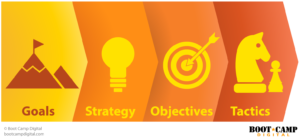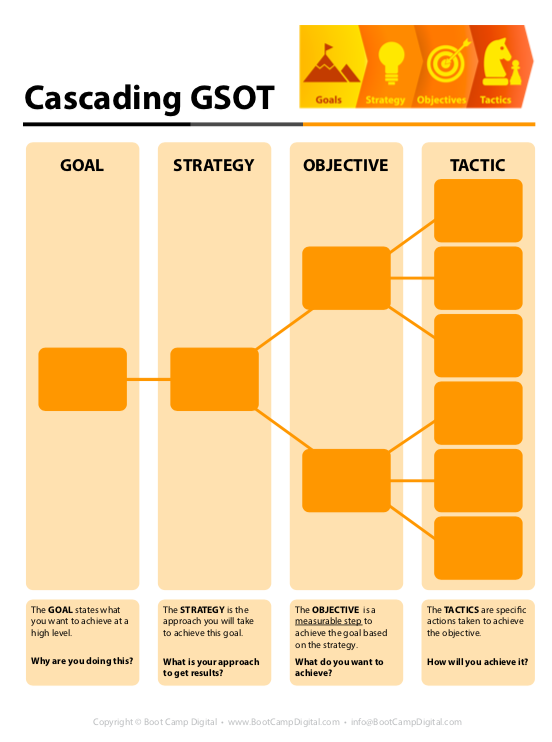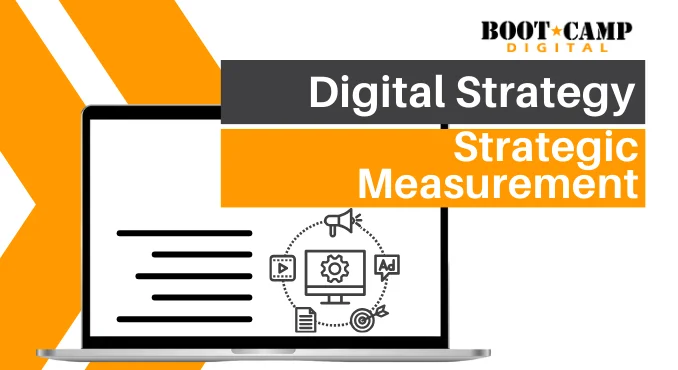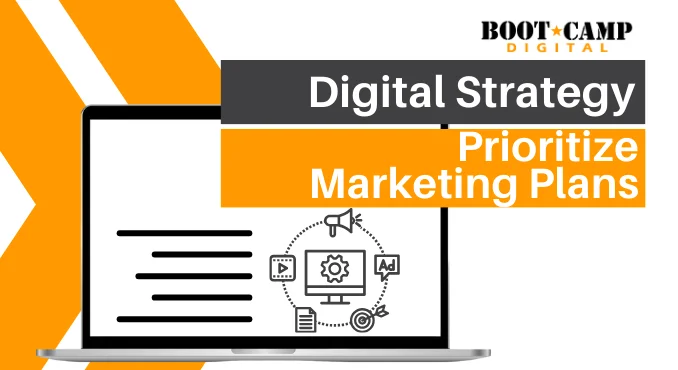There is lots of talk about “strategy” and “digital strategy”. After working with hundreds of thousands of marketers and reviewing countless digital marketing plans, it is clear that strategy itself is sometimes a challenging concept.
The phrases “we need to be more strategic” and “I’m not sure this aligns with our strategy” are often heard. But how exactly do you create a strategic digital marketing plan? How do you clearly define your digital marketing strategy?
In my recent book, Digital Marketing that Actually Works I spent time researching strategy and how to apply it to digital marketing. After years of research and training businesses, we adopted the GSOT model to clearly link digital strategy to execution.
GSOT: Goal, Strategy, Objective, Tactic

The First Step is your Goal
This is overall what you are aiming to achieve. This is often a high-level goal for an organization. A goal could be to increase sales X%, generate X donations, etc. The goal should be specific, measurable, attainable, relevant, and timely.
Next Determine your Strategy
The strategy is the approach that you will use to achieve your goal. For example, if you want to grow sales, are you targeting new users or existing users? Do you need to build awareness or drive conversions? Are you aiming to tackle one market or product at a time? Clearly define your strategy. It can be helpful to think about your strategy in the ANCRA model: Attract, Nurture, Convert, Retain or Advocate – which of these steps are you focusing on and why?

Once your Strategy is Clear, Set Objectives
The objectives are the tangible things that you want to achieve. These could be to generate a certain number of leads, grow brand awareness by a specific percentage, gain a specific amount of search traffic. Objectives are the clear and measurable things that you want to achieve from your digital marketing execution. You may have multiple objectives that you use to achieve your strategy.
Finally, Choose the Best Tactics
While it is often tempting to start with tactics, the best chance of success is to start with strategy and allow the strategy and objectives to help you prioritize your tactics. For example, if your objective is to generate leads you may need to tactically focus on on-site lead generation conversion rates and quality traffic. If your goal is awareness you may focus on digital advertising reach.
Setting Digital Marketing KPIs
KPIs should be set at the GOAL, OBJECTIVE and TACTIC level. For example you may have a goal of 5% sales increase, or $100K. The objective is to get 100 new leads a month. Each tactic should then have a KPI; increase organic search traffic by 5K visitors a month; increase conversion rate by 5% this year. As you can see in this example, KPIs should be set for each level. This is how you know what is or isn’t working.
Example: Using GSOT to Identify Your Digital Strategy
The key to success is having tight alignment between your Goal, Strategy, Objective and Tactic. Here is an example for a B2B business.
GOAL: Increase sales 10%; $200K
STRATEGY: Increase leads by 100 leads per month.
- OBJECTIVE 1: Improve conversion rate on site by 5%
- TACTIC: Landing page pop-up optimization (2% increase)
- TACTIC: Webinar for lead generation (3%)
- OBJECTIVE 2: Increase organic traffic to site by 10%
- TACTIC: Generate 5 new links/month from PR
- TACTIC: Improve site speed to 3 seconds to earn search in mobile.
- TACTIC: Create 2 keyword focused articles/month
- OBJECTIVE 3: Earn 10 leads/month from LinkedIn
- TACTIC: Train sales team on LinkedIn (100% trained)
- TACTIC: Sales team to grow network to over 500 targeted connections each
- TACTIC: Outbound messages to prospects (5/month/sales rep)
Diligence on your plan would include doing some basic math to make sure that your tactics are likely to achieve your objective.
Putting it All Together
As you put it all together in the GSOT Model, you can see how the digital strategy flows from the goal to the strategy to the objective to the tactic. To help you implement this below you’ll find our Digital Strategy Template where you can fill out your GSOT and your KPIs to get focused. To get more templates, resources and ideas check out our Digital Marketing Strategy Training Course.







![The BEST Social Media Network Comparison Cheat Sheet [Infographic]](https://bootcampdigital.com/wp-content/uploads/2024/10/Get-Ahead-of-the-Curve-with-The-Social-Media-Platform-Cheat-Sheet--300x167.png)
![Best Practices for Every Social Network Cheat Sheet [Infographic]](https://bootcampdigital.com/wp-content/uploads/2024/10/DMTAW-Blog-Image-Template-2022-1-3-300x167.png)












